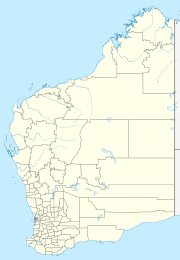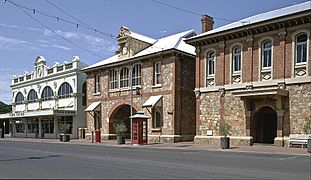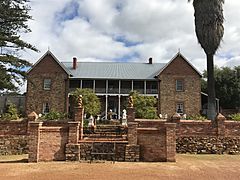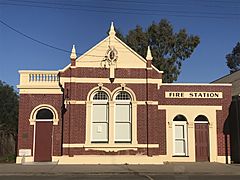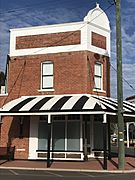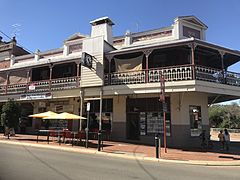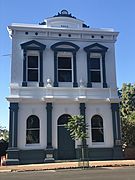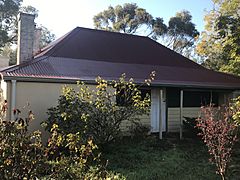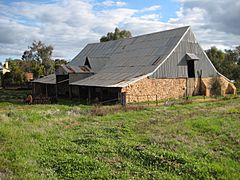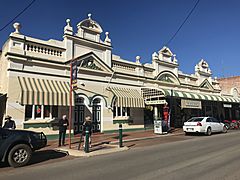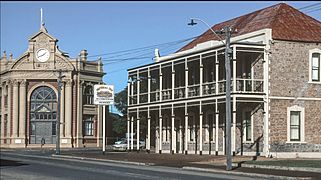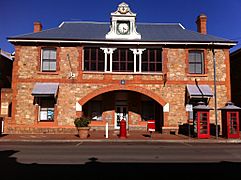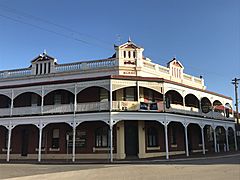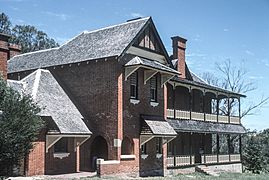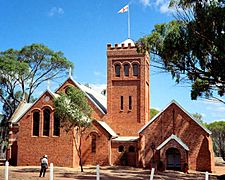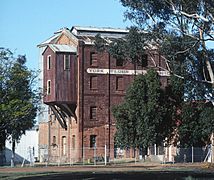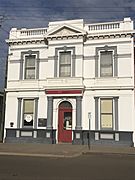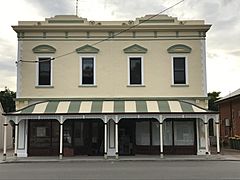York, Western Australia facts for kids
Quick facts for kids YorkWestern Australia |
|||||||||
|---|---|---|---|---|---|---|---|---|---|
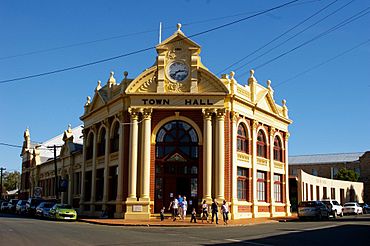
|
|||||||||
| Established | 1835 | ||||||||
| Postcode(s) | 6302 | ||||||||
| Elevation | 179 m (587 ft) | ||||||||
| Area | [convert: needs a number] | ||||||||
| Location | 96 km (60 mi) E of Perth | ||||||||
| LGA(s) | Shire of York | ||||||||
| State electorate(s) | Central Wheatbelt | ||||||||
| Federal Division(s) | Pearce | ||||||||
|
|||||||||
York is the oldest inland town in Western Australia. It sits on the Avon River. York is about 97 kilometers (60 miles) east of Perth. It is located in the Wheatbelt region. The town is on the traditional land of the Ballardong Nyoongar people. York is also the main town of the Shire of York.
The name "York" was suggested in October 1830. An explorer named JS Clarkson thought the area looked like his home county. He was from Yorkshire in England.
The Ballardong Nyoongar people lived here for thousands of years. Europeans first settled in 1831. This was two years after Perth was settled in 1829. York officially became a town in 1835. The first buildings were put up in 1836.
In the 1800s, York was important for farming. People raised sheep, cattle, goats, and pigs. They also grew grain and harvested sandalwood.
York grew very quickly during the gold rush. It was the last train stop before people walked to the goldfields.
Today, many tourists visit York. They come to see its beautiful old buildings and learn about its history. People also enjoy its festivals and art.
Contents
York's Early History
Who lived in York first?
The Ballardong people are a group of the Nyoongar people. They lived on this land for a very long time. They were here before Europeans settled.
How did Europeans settle York?
By 1830, the Swan River Settlement was growing. People needed more land to grow food. So, explorers looked for new areas.
Ensign Robert Dale was a young officer. In 1830, he led a small group over the Darling Range. This area later became known as the Avon Valley.
Dale reported finding "park-like lands with scattered trees." After a second trip, Lieutenant-Governor Stirling agreed. He thought there were 1,000 square miles of great land for sheep.
So, Stirling decided to open the new district for settlement. This happened on November 11, 1830. By December 1830, a lot of land had been given out.
In September 1831, Dale guided the first settlers to the area. They reached the Avon Valley on September 16. They quickly built huts and prepared the land. Dale suggested a spot for a future town. This spot was two miles south of Mount Bakewell.
When did York become a town?
In September 1833, soldiers were stationed in York. Rules for town land were made in September 1834. Land was advertised for sale starting in July 1835.
The town started to appear in 1836. By July 1836, York had two houses, a barn, and army barracks. About 50 acres of land were cleared. The town grew slowly at first. There were challenges with the local Aboriginal people. Also, English farming methods were hard to use in the new climate.
Revett Henry Bland settled in York in 1831. He and his partner, Arthur Trimmer, leased land north of town. They built the first house there by September 1831. They also started a farm to the south. This farm was later called Balladong Farm. It was named after the Ballardong Noongar people. Part of this land later became known as Bland's Town. Bland was a local judge from 1834 to 1842.
In 1836, John Henry Monger Snr arrived. He bought the land north of town from Bland and Trimmer. This land had the first house in York. Monger opened a hotel in early 1837. In 1842, he built a store across from his hotel. His wagons would travel to Guildford or Perth for supplies every three months.
Challenges and Growth
In July 1836, Lieutenant Henry William St Pierre Bunbury was sent to York. His job was to deal with rising tensions between settlers and Ballardong Noongar people. There were reports of violence. In response, Ballardong people speared a shepherd. Bunbury tried to keep this quiet to avoid more conflict.
In July 1837, Bunbury returned to York. This was after two young settlers were killed. More violence followed. Soldiers and settlers killed at least 18 Ballardong Noongar people.
In 1840, the York Agricultural Society was formed. It became very important. It still holds annual shows today. The York Racing Club was started in 1843. Both groups are still active.
Farmers in York needed more workers. This was especially true during harvest time. A boom in sandalwood in the late 1840s helped the town.
From 1851, convicts were sent to the Colony. This helped with the lack of workers. These "ticket-of-leave" men built many early buildings.
Solomon Cook built a flourmill in 1851. He added a steam engine in 1852 to power it.
York got a railway connection in 1885. Gold was discovered in the Yilgarn in 1887. After this, York was full of miners. They got off the train here. Then they prepared for the long journey to the goldfields.
In the 1880s, there was a big debate. Should the railway to the Goldfields go through York or Northam? People say that politicians were tired of the arguments. They suggested the towns decide with a game of cards. In December 1891, the government chose Northam. It was 15 miles shorter and £500 cheaper to build the line there.
The 1968 Meckering earthquake damaged many buildings in York. The Royal Hotel had to be removed.
Between 1968 and 1971, York faced a downturn. Farming activities slowed. Also, more railway operations moved to Northam. Many businesses in York closed. The population also decreased.
Things to See and Do in York
York is in a valley between Mt Bakewell and Mt Brown. The Ballardong Noongar people call these mountains Walwalling and Wongborel. In spring, the canola fields on the road to York are beautiful. They attract many tourists.
York has many historic and Arts and Crafts style buildings. The town also offers the York Motor Museum. You can visit the Courthouse complex and art galleries. There are also shops selling old items and books. For adventure, you can go skydiving or paragliding. You can also walk along the pretty Avon River or climb Mt Brown.
Main Attractions in Town
- Avon Terrace: This is the main street. It is lined with many old, historic buildings.
- The York Motor Museum: This museum has 60 vintage cars and 16 motorcycles. It also has other vehicles and motor history items.
- The York Town Hall: A grand and historic building.
- The Courthouse complex: This is now an art gallery. You can also see the old cells from 1852.
- Giant straw (wara art) sculptures: These sculptures show endangered animals.
- The Residency Museum: Learn about local history here.
- The Suspension Bridge: Also known as the Swing Bridge.
- Faversham House: A beautiful historic home.
- Blandstown: A rare old village with many homes from the 1800s. It has not been changed by modern development.
- Historic churches: These include St Patrick's Church, Holy Trinity Church, and the Uniting Church.
Attractions Outside Town
Outside the town, you can find Australia's oldest racecourse. Besides the historic Faversham House, York has four historic hotels: Settlers House, the York Palace Hotel, the Imperial Hotel, and the Castle Hotel. York is a popular place for walkers, cyclists, and photographers.
York also has a lovely wildflower garden behind Faversham House. There is also Avon Park, next to the river, and Peace Park.
The York Agricultural Show and The York Festival are usually held in September and October each year.
Historic Buildings in York
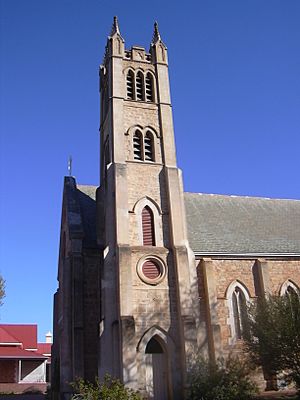
York has more heritage buildings than any other town of its size in Western Australia. The whole town has been named a "Historic Town" by the National Trust of Australia. York's streets are full of buildings that feel like they are from the 1800s. The main street, Avon Terrace, looks almost the same as it did in 1911. That was the year the amazing Town Hall was built. Behind the main street, there are many historic houses and cottages. Each has its own story.
York and its small village, Bland's Town, have buildings from every decade. These include homes from the early settlers (1830s and 1840s). There are buildings from the convict period (1850s and 1860s). You can also see buildings from when the railway arrived (1885). The Gold Rush (1887 to 1900) also brought new buildings. Finally, there are buildings from the Federation boom, ending with the York Town Hall (1911).
Faversham House is one of the grandest old homes in the state. It looks over the north end of Avon Terrace.
More than 200 buildings or sites in York are listed as heritage places. Most of these are in the town itself. Many of York's older homes and buildings have been fixed up. Some still have their original use, like the York Post Office. Others have been given new uses, like the old York Primary School (1886).
- Gallery of some Heritage Buildings in York
-
Co-op, York Post Office, Courthouse
York's Architecture and Art Styles
Arts and Crafts Style Buildings
George Temple-Poole was a main architect in Western Australia. He liked the Arts and Crafts Style. This style came from the Arts and Crafts Movement. It was inspired by William Morris and John Ruskin.
The railway station building was built in 1885. It is one of the earliest Federation Arts and Crafts buildings in Australia. It looks like a Cotswold cottage from Bibury in England. William Morris thought this was an ideal house design. The Old York Hospital looks similar to William Morris's own home, Red House. It is one of the most admired Arts and Crafts buildings in the state. The old York Primary School (1886) also has a design element from Red House.
Other Architectural Styles
Federation Free Style buildings are like the commercial version of Arts and Crafts. These include the York Post Office (1893). The Courthouse and police station (around 1896) are also in this style. All these were designed by Temple-Poole. They are on the State Heritage Register.
The center of York has many beautiful Victorian and Federation style buildings. There are almost no modern buildings to break the view. Victorian Georgian style buildings include parts of Settlers House and the Castle Hotel.
The Convent School House (1872) is a Victorian Tudor building. This style is similar to many early Perth buildings. It was probably designed by Richard Roach Jewell.
York's churches show different styles. The Anglican Holy Trinity Church (completed 1854) is Victorian Romanesque. It was designed by Richard Roach Jewell. St Patrick's original church was built from 1859–60. St Patrick's Church (completed 1886) is in the Gothic Revival style. It was designed by Joseph Nunan. The Uniting Church Chapel (1854) is Victorian Georgian. The Uniting Church (1888) is Victorian Academic Gothic.
The Catholic Presbytery is in Victorian Rustic Gothic style.
When the railway arrived in 1885, the Victorian Filigree style Imperial Hotel (1886) was built.
Buildings from the gold rush include the Federation Warehouse style York Flour Mill (1892). This is now a cafe and gallery at the entrance to York. Many buildings on Avon Terrace are also from this time.
The Western Australian Bank building was designed by JJ Talbot Hobbs. The Masonic Hall was designed by James William Wright. Both are in Victorian Academic Classical style.
Most of the main street, Avon Terrace, has Victorian or Federation Free Classical buildings. These include the Co-op (IGA) (1888 front). The York Motor Museum and Dinsdale's Shoe Emporium (1887) are also here. Dinsdale's was designed by Wright. At the north end, there are Federation Romanesque buildings. These include the former Fire Station (1897).
Early 1900s buildings are also impressive. The stunning Federation Mannerist style Town Hall (1911) was designed by Wright. The Castle Hotel (1905) is a great example of Federation Filigree style. It was designed by William G Wolf, who also designed His Majesty's Theatre.
- Gallery of some buildings in York of architectural interest
Important Buildings in York
- Castle Hotel
- Central Buildings
- Courthouse
- Convent and convent school
- Davies Buildings
- Dinsdale's Shoe Emporium
- Edwards' Store (former)
- Eliza's Cottage
- Faversham House
- Fire Station (former)
- Flour Mill
- Holy Trinity Church
- Hope Farm
- Hospital (Former)
- Imperial Hotel
- Kairey Cottage
- Kings Head Hotel (former)
- Marwick's Shed
- Masonic Hall (former)
- Mongers Store
- Motor Museum
- Nineteen Mile Inn (former)
- Post office
- School (Former)
- Railway station building
- Residency Museum
- Sargent's pharmacy
- St Patrick's Church
- Settlers House
- Suspension Bridge
- Town Hall
- Uniting Church
- Western Australian Bank (former)
- York Palace Hotel
Famous People from York
York has been home to or connected with many interesting people.
- Chance Bateman: A former AFL player for the Hawthorn Football Club.
- Enid Bennett: A silent film actress.
- Marjorie Bennett: An Australian-born television and film actress.
- Revett Henry Bland: An early settler and York's first local judge.
- Eliza Brown: Her letters about early settler life were published.
- Henry William St Pierre Bunbury: A military officer stationed in York. A military post was named after him.
- Solomon Cook: An American engineer who built York's first flourmill.
- Robert Dale: An explorer who discovered the Avon Valley.
- Zac Fisher: An AFL player for the Carlton Football Club.
- Paul Hasluck: A politician who became Governor–General of Australia. He lived in York when he was young.
- Richard Roach Jewell: An architect who designed several buildings in York.
- Moondyne Joe: Western Australia's most famous bushranger (an outlaw).
- Robert Juniper: An artist known for the stained glass windows in Holy Trinity Church.
- Joseph Nunan: A former convict and architect who designed St Patrick's Church.
- Marlion Pickett: An Australian rules footballer for the Richmond Football Club in the Australian Football League (AFL).
- Tommy Windich: An Indigenous person who joined famous expeditions.
Services and Facilities in York
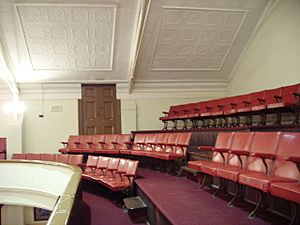
The York Visitor Centre is located in the Town Hall.
York has all the important services you need. It has the York District High School for students from kindergarten to Year 10. The York Community Resource Centre helps people access university education. There is a medical service available 24/7 at the York District Hospital. The town also has a library and a swimming pool.
York has its own community radio station, Voice of the Avon 101.3FM. It started in 1994. Volunteers run the station. They play music 24/7 and host their own shows for many hours each week.
York's Climate
York has a temperate climate. This means it has very dry and hot summers. Its winters are cool and wet. This type of weather is called a Mediterranean climate. York's summer afternoons are hotter than in Perth. There is a big difference compared to the Fremantle coast. Winters in York often have cold nights. This is because it is further from the ocean. Sometimes, there can be frost at night during the colder months.
Weather data has been collected in York for many years. The Bureau of Meteorology recorded data at the York Post Office from 1877 to 1996. Then, a new site started recording in 1996.
At the post office, the average highest temperature each day is 24.7°C (76.5°F). The average lowest temperature is 10.5°C (50.9°F). January is the hottest month. Its average high temperature is 33.6°C (92.5°F). July is the coolest month. Its average low temperature is 5.3°C (41.5°F). These averages are based on data from 1880 to 1996.
York gets an average of 449.8 millimeters (17.7 inches) of rain each year. June is the wettest month with 87.9 millimeters (3.46 inches). January is the driest month with only 9.5 millimeters (0.37 inches).
On January 27, 2011, a strong thunderstorm hit York. It ripped off roofs, uprooted trees, and brought down power lines. About 40 houses in town were damaged. Luckily, no one was hurt.
| Climate data for York and York Post Office (averages: 1880–1996; extremes: 1934–2016) | |||||||||||||
|---|---|---|---|---|---|---|---|---|---|---|---|---|---|
| Month | Jan | Feb | Mar | Apr | May | Jun | Jul | Aug | Sep | Oct | Nov | Dec | Year |
| Record high °C (°F) | 46.6 (115.9) |
47.4 (117.3) |
43.4 (110.1) |
39.0 (102.2) |
34.4 (93.9) |
25.6 (78.1) |
25.4 (77.7) |
27.9 (82.2) |
33.7 (92.7) |
40.0 (104.0) |
42.3 (108.1) |
45.5 (113.9) |
47.4 (117.3) |
| Mean daily maximum °C (°F) | 33.6 (92.5) |
32.9 (91.2) |
30.0 (86.0) |
25.5 (77.9) |
20.6 (69.1) |
17.4 (63.3) |
16.4 (61.5) |
17.5 (63.5) |
20.1 (68.2) |
23.4 (74.1) |
27.9 (82.2) |
31.5 (88.7) |
24.7 (76.5) |
| Mean daily minimum °C (°F) | 16.6 (61.9) |
16.7 (62.1) |
14.8 (58.6) |
11.3 (52.3) |
8.0 (46.4) |
6.4 (43.5) |
5.3 (41.5) |
5.4 (41.7) |
6.5 (43.7) |
8.4 (47.1) |
12.0 (53.6) |
14.9 (58.8) |
10.5 (50.9) |
| Record low °C (°F) | 7.4 (45.3) |
6.8 (44.2) |
3.2 (37.8) |
0.6 (33.1) |
−3.2 (26.2) |
−4.0 (24.8) |
−5.2 (22.6) |
−3.0 (26.6) |
−2.2 (28.0) |
0.0 (32.0) |
0.4 (32.7) |
2.7 (36.9) |
−5.2 (22.6) |
| Average rainfall mm (inches) | 9.5 (0.37) |
14.6 (0.57) |
16.8 (0.66) |
24.1 (0.95) |
60.5 (2.38) |
87.9 (3.46) |
85.5 (3.37) |
65.9 (2.59) |
37.4 (1.47) |
25.5 (1.00) |
12.6 (0.50) |
10.1 (0.40) |
450.4 (17.72) |
| Average rainy days (≥ 0.2mm) | 1.4 | 2.2 | 2.7 | 5.8 | 9.9 | 14.6 | 15.3 | 13.1 | 10.0 | 6.4 | 4.2 | 2.1 | 87.7 |
| Source: Bureau of Meteorology | |||||||||||||


